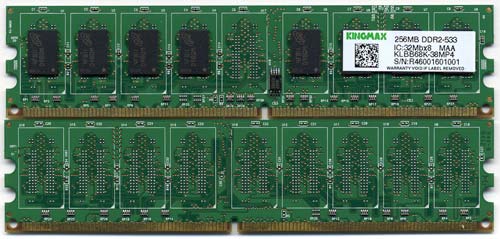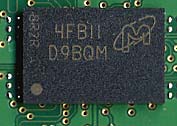DDR2 Roundup: Reaching for 667 and Beyond
by Wesley Fink on July 8, 2004 12:09 AM EST- Posted in
- Memory
Kingmax DDR2-533
Kingmax may not be as familiar to US readers, but Kingmax is a very large supplier of memory products in Asia. You will also find Micron chips in many Kingmax products, and that is the case with the Kingmax DDR2-33.
Test DIMMs were a matched pair of single-sided 256MB DDR2 533 DIMMs without heat spreaders. We would have preferred Kingmax to supply 512MB samples for testing, but these 256MB modules will provide a rough idea of the performance penalty, if any, with 256MB single-sided modules. You may recall in our Searching for the Memory Holy Grail - Part 2 article that single-sided modules performed more poorly than double-sided on the 875/865 chipsets.
As already mentioned, the top-performing Micron memory chips were used in the Kingmax DDR2 533 DIMMs.

Test Results: Kingmax DDR2-533
The full suite of benchmark tests were run at all memory speeds. This includes Quake3, Super PI, Sandra 2004 SP2 Memory Tests, Aida 32 Memory Tests, and Return to Castle Wolfenstein-Enemy Territory. We also ran UT2003, Aquamark 3, and Comanche 4 at every memory speed to verify stability of the reported memory timings. All benchmarks and additional tests had to complete without incident for the memory settings to be considered stable.| Kingmax DDR2-533 (DDR2 533) - 2 x 512Mb Single-Bank | |||||
| Speed | Memory Timings & Voltage | Quake3 fps | Sandra UNBuffered | Sandra Standard Buffered | Super PI 2M places (time in sec) |
| 533DDR 800FSB |
3-3-3-10 1.85V |
369.4 | INT 2955 FLT 3038 |
INT 4903 FLT 4903 |
107 |
| 667DDR 1000FSB |
4-4-4-10 1.9V |
454.6 | INT 3484 FLT 3605 |
INT 6076 FLT 6077 |
86 |
| 686DDR 258FSB |
4-4-4-10 1.9V |
466.7 | INT 3555 FLT 3661 |
INT 6245 FLT 6247 |
84 |
| Kingmax DDR2-533 (DDR2 533) | ||||
| Speed | RCW-ET Radar |
Aida 32 Read |
Aida 32 Write |
Aida 32 Total |
| 533DDR 800FSB |
78.2 | 5424 | 2177 | 7601 |
| 667DDR 1000FSB |
97.1 | 6608 | 2600 | 9208 |
| 686DDR 258FSB |
99.7 | 6754 | 2645 | 9399 |
Since Kingmax uses the same Micron chips as Micron, Crucial, and Corsair, the performance should be at the top of the charts. Generally, the Kingmax is one of the better performers in this roundup, but the 512MB total memory and/or single-sided configuration holds Kingmax back from the top of the charts. Since Crucial and Micron had no trouble with 667 and 686 memory speeds, it is not a surprise that Kingmax performs at the same timings and low voltages.










20 Comments
View All Comments
betatest3 - Wednesday, August 18, 2004 - link
The DDR2 667 memory is allready available and price is around $245 to $270 for 512mb .The only memory I found was made by Crucial and some Generic by doing a search on pricewatch.com site The $245 memory can be seen here -->http://www.newegg.com/app/viewproductdesc.asp?DEPA...
Hmm.. this DDR2 memory was just made for Intel ??? or maybe in newer motherboards can be used with AMD also ? I would not think a newer memory made by many company's would just be designed for intel especially when alot of manufacturers are jumping over to AMD or can AMD use this 667 memory ?
jiulemoigt - Monday, July 12, 2004 - link
A very funny thought aquired to me after reading the older article on AMD's DDR2 stance. If their waiting for DDR2 667 and the memory is ready but quitly being called 533 does that mean AMD may actully be ready to pull a fast on Intel? Considering the way the chip is designed could the memory controller be flashed to update to the memory controller the same way the other frequencies are set? Oh and I would not buy a LGA socket the pin's being spring loaded just looks to be trouble :o cool articleWesley Fink - Friday, July 9, 2004 - link
FlameDeer -Good catch. P. 6 is corrected to 1032FSB.
FlameDeer - Friday, July 9, 2004 - link
Thanks for quick respond at #10, Wesley! :)Really appreciate your hours and hours of hard work to publish this very first hand thorough DDR2 roundup! :)
A quick look again of this good article, I noticed something need to ask. In page 7 till page 14, is that "258FSB" of 686DDR in every table mean 4 x 258 = "1032FSB"? And is this FSB related to page 6 settings no.3 of "1016FSB/DDR2-686"? Just curious, thank you! :)
pookie69 - Friday, July 9, 2004 - link
Cool - i think i understand that now.Thanks for replying and explaining. Appreciated :)
Wesley Fink - Friday, July 9, 2004 - link
The ratio is 3:4 looking at base clocks (200 to 266). The bus is then quad-pumped to 800 and memory is DOUBLE Data Rate or 533. I do agree it is a bit confusing since the final 800 ratio is 3:2 of the final DDR2 ratio (533).The 975/865 standard was 1:1 since the base clocks are 200, even though the final speeds were 800FSB (quad) and 400 DDR. It was never called 2:1.
pookie69 - Friday, July 9, 2004 - link
Nice article - good job :)Only one point; where it reads;
"This is currently slightly below the memory timing of 250 required to run memory at DDR2 667, at the standard 3:4 Intel memory ratio for DDR2."
>>> shouldn't that be a 3:2 ratio?
Or am i confused :S
Nice article again - keep up the good work Mr. Fink ;)
TrogdorJW - Friday, July 9, 2004 - link
I think a better conclusion might have been: And the winner is... NO ONE! (Or everyone, depending on whether you see the glass as half full or half empty.) While there are definitely measurable differences in performance between the various memories, reality is that only Quake 3 and Enemy Territory are meaningful benchmarks. Seeing that Quake 3 is one of the most bandwidth hungy games of all time, it's rather telling that a 15.4% advantage in Sandra only equates to a 2.7% performance difference in Quake 3 (and even less in W:ET). I'm not criticizing your work, mind you - just pointing out that the best case scenario of Sandra Unbuffered RAM tests are not the way we actually use our systems.At some point, it would be nice to see a memory roundup that included all the benchmarks that are used in CPU and graphics comparisons. Obviously, that wouldn't be a prudent use of your time when we're still being limited by the motherboard. However, in another six months, I would like to see a memory comparison put together that broadened the field of view in regards to benchmarks.
Great article, though. It will certainly be interesting to see how far each memory type can actually overclock when the motherboard is no longer the limiting factor. For the present, though, it looks like we might as well just save our pennies and buy cheaper DDR2 modules. (Not that any of them are actually "cheap"....)
Pumpkinierre - Thursday, July 8, 2004 - link
I suppose with all these new goodies, Wesley, you are going to give up on the excellent straight DDR articles you used to do.For the tRAS, the usual formula for DDR is: tRCD+CAS latency + 2 cycles, see:
http://www.mushkin.com/mushkin/pop-up/latencies.ht...
So that seems to work for DDR2 at tRAS >10. I dont know why DDR2 still works at tRAS of 4 though. I also dont know why nForce chipsets have their tRAS so high (10-12) on ordinary DDR.
You've got an engineering sample (multiplier unlocked) Prescott that o'clocks well. So you ought to do some tests at same CPU speed but different FSBs like you have done on the a64s. I know you might think it is stupid given that retail cpus are multiplier locked but some of us want to see whether it is better to put more money in a higher grade cpu or get a cheaper one and o'clock it high using more expensive high speed low latency memory. You had'nt done this with the N'wood/i875 memory tests either, but I cant remember whether you've got a good N'wood engineering sample lying around. Anyway just a suggestion.
ariafrost - Thursday, July 8, 2004 - link
Now if only DDR2 latencies were lower and the pricetag was less than DDR1 :)